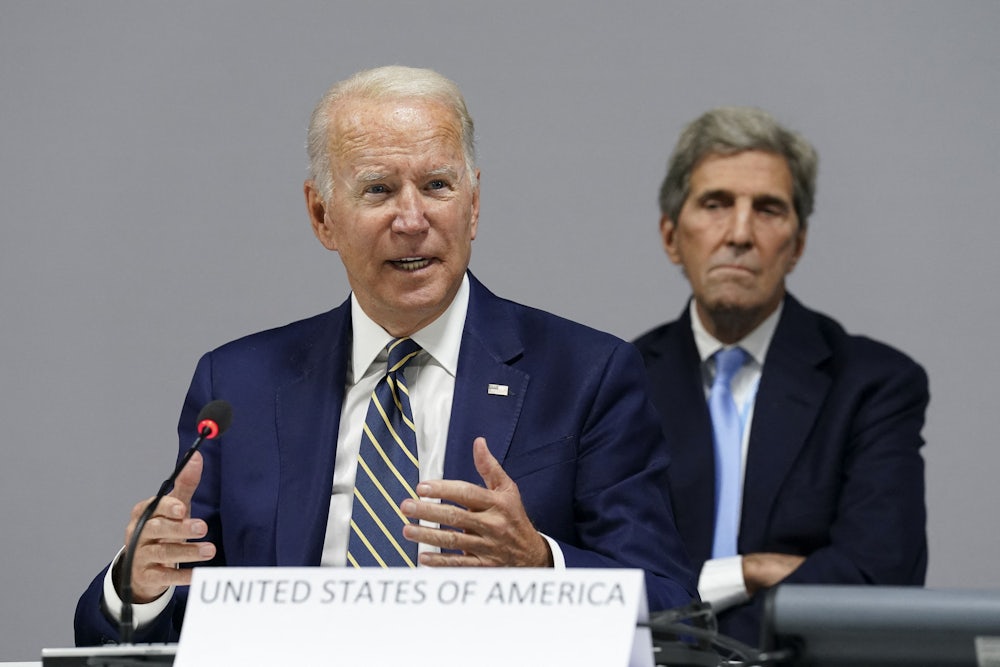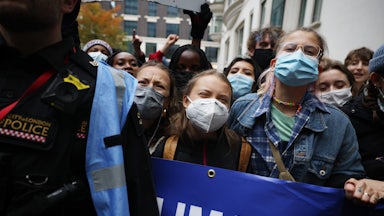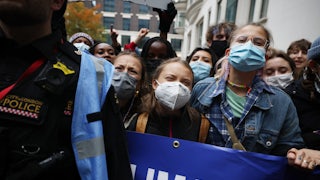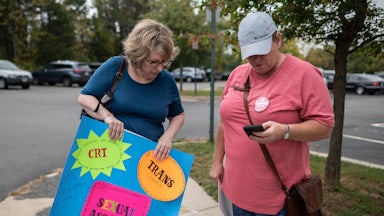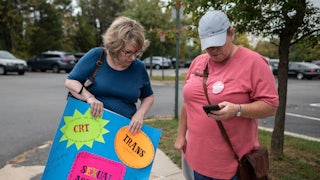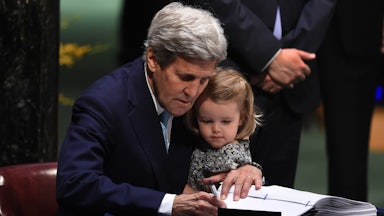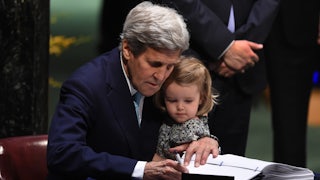In front of Glasgow cameras these last two weeks, world leaders trumpeted flashy commitments on everything from methane emissions to deforestation. The Biden administration projected a mood of triumphant return, signaling it had once again ascended to a seemingly natural position of leadership at the U.N. Framework Convention on Climate Change, the treaty under which the Paris Agreement is housed. “We are in fact closer than we have ever been before to avoiding climate chaos and securing cleaner air, safer water, and a healthier planet,” U.S. climate envoy John Kerry boasted to reporters after talks concluded in overtime this weekend.
But privately, COP26 attendees from climate-vulnerable countries told a very different story: one in which, behind closed doors, current U.S. negotiators bullied other countries and blocked more ambitious agreements, just as their predecessors had done.
“Biden got elected on the platform of [confronting] climate change and environmental justice. And while he may be doing OK in the domestic space, internationally he isn’t much different from the previous Trump administration. If you look at the solidarity elements—finance, adaptation, loss and damage—the U.S. is still the biggest blocker,” said Mohamed Adow, director of the climate and energy think tank Power Shift Africa.
Among the key points of contention this year, Adow noted, was climate finance. Creating a facility for loss and damage funds would allow countries to recover from climate-fueled disasters. Just how much loss and damage funding will be needed depends, in large part, on the amount of money countries are willing to spend now on a range of preventative measures: If infrastructure is strengthened and coastal areas fortified—and if emissions are limited—countries will face less damage when storms and floods hit. But the fewer resources that are used for the mitigation of greenhouse gas emissions, the more countries will need to adapt to the new world created by temperature rise and extreme weather. And if relatively little is spent on mitigation and adaptation now, the costs of responding to climate damage could reach up to $700 billion per year by 2030.
In the final hours of COP26, a delegate supporting developing countries who was in the negotiating rooms and wished to remain anonymous described the U.S. stance on loss and damage as an “immovable object.” The United States has continually emphasized only mitigation, and fought to constrain conversations about loss and damage or even arriving at a clear definition of what constitutes climate finance. Rich countries have already broken a pledge to deliver $100 billion in climate financing—whatever they imagine that phrase to mean. Some 80 percent of the funds already delivered, Oxfam has found, are in the form of loans, trapping many countries already loaded with debt in even more of it just to survive.
America’s red line on climate finance, past and present, has been any language reflecting the outsize historical responsibility of wealthy nations for the climate crisis. The U.S. alone is responsible for 40 percent of excess emissions since the dawn of the industrial age. And officials fear putting compensation for that outsize role on the table could open the door to the U.S. and other wealthy countries having to pay something like their fair share. “There’s one thing that we don’t accept and won’t accept in this agreement and that is the notion that there should be liability and compensation for loss and damage,” top Obama-era negotiator Todd Stern told reporters as the Paris Agreement was being brokered in 2015. “That’s a line that we can’t cross. And I think in that regard we are in the exact same place, my guess is, with virtually all if not all developed countries.”
But the technical nature of those battles like the one over loss and damage make them harder to track than the showy announcements apportioned out by COP26’s U.K. hosts. Newspaper readers and network watchers don’t need expert command of procedural history or a battery of acronyms to understand that a $130 trillion private financing pledge sounds big; or that asset managers pledging, at some point, to think about aligning their portfolios with net-zero by 2050 sounds like progress; or that ending deforestation by 2030, as more than 100 countries pledged to earlier this month, looks good. The problem, though, is that “there’s no clear roadmap, no deliberate goals. There’s a lot of talk and pledges outside … signing this and signing that,” said Meena Raman, head of programs at the Third World Network, which tracks the ins and outs of the UNFCCC and other multilateral processes. “They are not commitments that can be measured and verified and reported. None of this is. It’s a circus.”
“The baseline is really low,” Raman added, referring to America’s reentry to the Paris Agreement. “You walked out of the Kyoto Protocol. You walked out of Paris. You come back and want us to think you’re doing more? What you’re actually encouraging is people to walk out and then come back. And then you are applauded.”
Despite America’s well-documented obstinacy on climate finance issues, much of the public blame for a disappointing outcome toward the end of COP26, as countries coalesced around an agreement, fell on India. Earlier in the week, there had been excitement about fossil fuels being mentioned in the draft of what would become the Glasgow Climate Pact, calling for a phaseout of fossil fuel subsidies and a coal phaseout. But on Saturday, as delegations huddled to finalize the text, Environment Minister Bhupender Yadav cited India’s enormous lack of access to electricity and appeared to lead the charge on changing the reference to a “phaseout” of coal to a “phase down.” As it happened, China and the U.S. had each backed the same change in language, but wealthy countries nevertheless cast themselves as the defenders of ambition. Fighting back tears, U.K. COP 26 president Alok Sharma said he was “deeply sorry” for how the process had gone, and European Commission Vice President Frans Timmermans lambasted the developing economy ministers who spoke before him, appealing to the “hearts of our children and grandchildren.” U.S. officials were similarly happy to call out China and India for lacking ambition on fossil fuels in Scotland, despite the obvious hypocrisy: The Biden administration is preparing to hold the largest offshore oil and gas lease sale in U.S. history this week.
Not so long ago, a different state of play in the U.N. looked possible. The U.N. exploded in size in the middle of the twentieth century, from a 51-nation founding membership to 138 by the mid-1970s, as countries fought for and won their independence. Those newly freed states accordingly saw the U.N. as a venue for planetary justice, given the General Assembly’s potential to put freed colonies on equal footing with their colonizers. Amílcar Cabral, the postcolonial theorist and assassinated leader of the Party for the Independence of Guinea and Cape Verde, referred to the U.N. as “a giant with its hands tied.” If “its institutions were democratized and its voice strengthened to include these hundreds of millions of human beings,” he argued, “it may fully serve the noble cause of freedom, fraternity, progress, and happiness for mankind.” The G77 plus China—a still forceful, if divided, bloc of 134 countries—was formed in 1964 in part to make that vision a reality.
A U.N. designed in the spirit that Cabral hoped—as a platform for the majority of the world to have a proportionate say over its governance—might well also have already taken on the climate crisis. Hopes for such an institution were snuffed out, though, as plans for it were felled by (among other factors) an oil shock that made it easier for the U.S. to fracture solidarity among developing nations of the self-described Third World, who found themselves paying more for fossil fuels and U.S. dollars. Daniel Patrick Moynihan, the liberal senator who argued Black communities suffer from a culture of poverty and who served as ambassador to India, warned that the U.S. needed to take a more aggressive stance within a U.N. teeming with a multiracial group of Communists and socialists. Among his biggest fears was that the U.S. might be forced to make some kind of material commitments to the U.N.’s “new majority.” America, he thought, might even find its easy access to key resources controlled by the people who governed the countries where those resources came from, as outlined by the New International Economic Order endorsed by the General Assembly in 1974. “A vast majority of the nations of the world,” he wrote in response to events that year, “feel there are claims which can be made on the wealth of individual nations that are both considerable and threatening—in any event threatening to countries such as the United States, which regularly finds itself in a minority (often a minority of one or two or at most a half-dozen) in an assembly of 138 members.”
He summed up his antidote to that succinctly in an interview the same year with The New York Times: “It is time for the United States to go into the United Nations and every other international forum and start raising hell.” Secretary of State Henry Kissinger adopted a similar stance. “We can resist confrontation and rhetorical attacks if other nations choose that path,” he said. “And we can ignore unrealistic demands and peremptory demands.”
That history seemed to come to life at the COP26 climate summit. Kicking off the talks, Barbados Prime Minister Mia Mottley called on wealthy countries to use the enormous power of their central banks to finance bonds for the energy transition, and support a $500 billion extension of IMF Special Drawing Rights. “Our world, my friends, stands at a fork in the road—one no less significant than when the United Nations was formed in 1945,” Mottley said. “But then, the majority of our countries here did not exist. We exist now. The difference is, we want to exist one hundred years from now.”
“The U.S. is calling itself a global leader on one hand and then playing hardball not to give any money to people losing their homes,” said Harjeet Singh, a New Delhi–based senior adviser to Climate Action Network International. “It’s the same United States. It has not changed, and of course John Kerry ensures the continuity of those positions because he has been at the helm. On loss and damage, they just keep saying absolutely not,” he said. “They wanted the whole text to be removed.”
Under enormous pressure from climate-vulnerable countries and civil society groups, the U.S. eventually on Saturday made peace with a “dialogue” on loss and damage, in place of a financing facility that could actually distribute funds. That Kerry mentioned loss and damage at all in his closing remarks, Singh observed, showed just how much work had been done to push that debate off the fringes of climate talks.
Some, though, fear a dialogue might be worse than nothing. “They want to basically open what we call in this process a never-ending talk shop,” Adow told me, referencing the largely fruitless Suva and Talanoa Dialogues concluded and begun, respectively, in 2018. (The latter borrowed its name from a traditional Fijian process for resolving differences, and was first proposed by the Fijian COP presidency in 2017.) “We’re better off sustaining the momentum we’ve built here and taking that to the capitals in a way that when we come back to the table next year we’re able to actually secure the facility. If we end up with a decision that only includes dialogue, that closes the opportunity for a facility, at least for the next three years.”
While wealthy countries acknowledged gaps in the Glasgow Climate Pact, those gaps represent an urgent threat to less wealthy and more climate-vulnerable countries, who represent a majority of the world’s population. “What is balanced and pragmatic to other parties will not help the Maldives adapt in time,” Maldives Environment Minister Shauna Aminath told the plenary. “While we recognize the foundation that this outcome provides, please do us the courtesy to acknowledge that it does not bring hope to our hearts but another conversation where we put our homes on the lines.”
“There’s this ridiculous sense that somehow this decision had come about through consensus. There is no consensus here,” says Jean Su, energy justice director and senior attorney at the Center for Biological Diversity, and board chair of Climate Action Network International. “Every low-lying state said, ‘In the spirit of compromise cede my position,’” Su told me as events wrapped up. “No one had the power to voice opposition. That is the duress of diplomacy. They are being forced to say yes to being sacrificed. This isn’t a consensus agreement. This is an agreement of force.”
